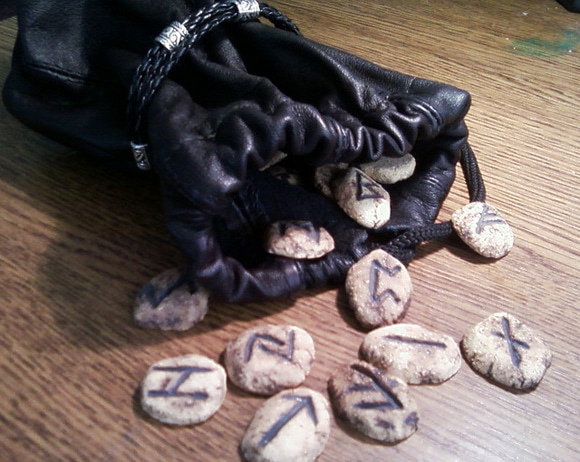 Image source: Nathaniel_U on Flickr
Image source: Nathaniel_U on Flickr
Runes bring the magic and mystery of our ancient ancestors to our doorsteps. During a time when magic lived in the world as an everyday and accepted source of power, runes were created. They served as the alphabet of the ancient Germanic languages and as powerful talismans for divination and protection against evil.
The name 'rune' means "secret, something hidden". It indicates knowledge of the runes was originally considered esoteric, or restricted to an elite.
Ancient texts describe runes as the creation of the god Odin who received them in a quest of self-sacrifice to gain power over the nine worlds. He did this by hanging nine days and nights from the great World Tree Yggdrasil impaled painfully on his own spear. Initiates into Germanic and Nordic esoteric rites would reenact Odin's sacrifice to gain knowledge and mastery of magical practices including the reading of runes.
A set of runes is comprised of twenty-four letters of the ancient Futhark alphabet. Each letter has a specific esoteric meaning that addresses everyday and spiritual concerns. They represent objects, gods, people, animals, concepts and occurrences. Rune sets are usually made of ceramic, wood, bone or stone.
The precise history of the use of runes is not known. While runes are the alphabets of ancient European peoples, they may have been invented for ritualistic and shamanistic work prior to being adopted as an alphabet. Rune-like symbols have been discovered in early Bronze Age caves dating back to 1300 BC.
There is academic debate over the inception of runes as an alphabet. Arguments have been made for both Latin and Greek derivation. But other academicians point out the similarities with Roman letters that originated from the Etruscan alphabet. This would place the creation of the original Futhark runes between two hundred and one hundred years before the birth of Christ. Once created, the northern tribes quickly imbued symbolic meaning into these ancient letters, reflecting the different aspects of their everyday lives. By 200 AD, runes as an alphabet and a divination tool were widely used by Northern European peoples. By around 200 AD the art of rune interpretation was widespread in Northern Europe. As the centuries marched on, and these tribes moved into different areas, they took their runes with them. However, exposure to new tribal languages led to the adoption of new runes to accommodate new sounds.
Runes were used both as language and a divination system continued into the 17th century until the Catholic Church banned their use as works of the devil. The rune masters were either executed or went underground, and the knowledge of the runes may well have died with them. It wasn't until the New Age Movement in the 1980's that runes saw resurgence in popularity.
There are various methods of casting runes. Some readers toss the runes to scatter in random patterns; others are more structured like the reading below. The type of reading is determined by the circumstances of the client.
Selecting one rune from a pouch is a good way to get an answer to a specific question. Pulling three runes, a Norn reading, produces an overview of the situation and a possible future outcome.
A nine-rune reading gives a detailed reading of a client's situation. Nine runes are picked from a pouch and then cast on a flat surface. How the runes fall indicate their importance to the question at hand. The reader will look at the position of the runes, and make judgments on how they relate to each other. Runes face up talk about current circumstances, and the ones in the center the most relevant to the situation at hand. Runes that are close together or even touching often compliment each other, or may even represent a single thing, while runes that fall on opposite sides of the pattern frequently represent opposing influences. The runes that are face down are indicators of future events.
Every reader has their own method, and one method is no more valid than another.
The following reading was a question from an author wondering if she would find a market for her fiction books. The cross spread was chosen to give an overview of the situation.
The rune on the left is Fehu, representing the past is the rune wealth, particularly the wealth garnered by work activity. The rune is reversed depicting loss. Here this rune accurately reports the past situation. The author lost her well-paying corporate job through downsizing and has been unable to find a comparable job.
The middle rune is Berkana, the sign of the birch tree. Berkana indicates good outcomes from ventures undertaken. Frequently it symbolizes renewal, birth, and growth coming from a well-run household. Since the author works from home this rune is saying that activities in the home brings good fortune.
The top rune is Thurisaz, the thorn. The thorn indicates barriers and challenges, but here Thurisaz is overturned. Barriers will fall and challenges overcome. Whatever was holding the author back will dissolve.
The bottom rune, Othila, is the symbol of what you inherit. The rune is reversed, indicating obstacles come from the client's own origins. If the author feels held back, it is from original concepts of self that have no place in her life now.
The right rune signifies the future and the final outcome. This rune is Inguz, the symbol of completion. Initiated actions will come to fruition, indicating that hard work will result in anticipated rewards.
Runes have an amazing way of connecting with everyday issues and concerns. A good reading will bring up enough information for you to be confident that the reader is given information that pertains directly to your circumstances. If you are looking for some concrete information to help you make choices a rune reading is right for you.
The Origin of Runes– http://www.runemaker.com/history.shtml
The History of Runes– http://www.tarahill.com/runes/runehist.html
Picture Credits:
Sacrifice of Odin by Frolich, public domain retrieved from http://en.wikipedia.org/wiki/Odin#mediaviewer/File:The_Sacrifice_of_Odin_by_Frølich.jpg

